|
|
General: JUAN 10:22-¿PORQUE JANUKAH TIENE REFERENCIA A 9 MESES LUNARES EXACTOS?
Elegir otro panel de mensajes |
|
|
JESUCRISTO SE EXPRESA EN CLAVE CON CODIGOS EGIPTOLOGICOS Y MASONICOS
Juan 7
1. Después de estas cosas, andaba Jesús en Galilea; pues no quería andar en Judea, porque los judíos procuraban matarle.
2. Estaba cerca la fiesta de los judíos, la de los tabernáculos;
3. y le dijeron sus hermanos: Sal de aquí, y vete a Judea, para que también tus discípulos vean las obras que haces.
4. Porque ninguno que procura darse a conocer hace algo en secreto. Si estas cosas haces, manifiéstate al mundo.
5. Porque ni aun sus hermanos creían en él.
6. Entonces Jesús les dijo: Mi tiempo aún no ha llegado, mas vuestro tiempo siempre está presto.
7. No puede el mundo aborreceros a vosotros; mas a mí me aborrece, porque yo testifico de él, que sus obras son malas.
8. Subid vosotros a la fiesta; yo no subo todavía a esa fiesta, porque mi tiempo aún no se ha cumplido.
9. Y habiéndoles dicho esto, se quedó en Galilea.
10. Pero después que sus hermanos habían subido, entonces él también subió a la fiesta, no abiertamente, sino como en secreto.
11. Y le buscaban los judíos en la fiesta, y decían: ¿Dónde está aquél?
12. Y había gran murmullo acerca de él entre la multitud, pues unos decían: Es bueno; pero otros decían: No, sino que engaña al pueblo.
13. Pero ninguno hablaba abiertamente de él, por miedo a los judíos.
14. Mas a la mitad de la fiesta subió Jesús al templo, y enseñaba.
15. Y se maravillaban los judíos, diciendo: ¿Cómo sabe éste letras, sin haber estudiado?
16. Jesús les respondió y dijo: Mi doctrina no es mía, sino de aquel que me envió.
17. El que quiera hacer la voluntad de Dios, conocerá si la doctrina es de Dios, o si yo hablo por mi propia cuenta.
18. El que habla por su propia cuenta, su propia gloria busca; pero el que busca la gloria del que le envió, éste es verdadero, y no hay en él injusticia.
19. ¿No os dio Moisés la ley, y ninguno de vosotros cumple la ley? ¿Por qué procuráis matarme?
20. Respondió la multitud y dijo: Demonio tienes; ¿quién procura matarte?
21. Jesús respondió y les dijo: Una obra hice, y todos os maravilláis.
22. Por cierto, Moisés os dio la circuncisión (no porque sea de Moisés, sino de los padres); y en el día de reposo circuncidáis al hombre.
23. Si recibe el hombre la circuncisión en el día de reposo, para que la ley de Moisés no sea quebrantada, ¿os enojáis conmigo porque en el día de reposo sané completamente a un hombre?
24. No juzguéis según las apariencias, sino juzgad con justo juicio.
25. Decían entonces unos de Jerusalén: ¿No es éste a quien buscan para matarle?
26. Pues mirad, habla públicamente, y no le dicen nada. ¿Habrán reconocido en verdad los gobernantes que éste es el Cristo?
27. Pero éste, sabemos de dónde es; mas cuando venga el Cristo, nadie sabrá de dónde sea.
28. Jesús entonces, enseñando en el templo, alzó la voz y dijo: A mí me conocéis, y sabéis de dónde soy; y no he venido de mí mismo, pero el que me envió es verdadero, a quien vosotros no conocéis.
29. Pero yo le conozco, porque de él procedo, y él me envió.
30. Entonces procuraban prenderle; pero ninguno le echó mano, porque aún no había llegado su hora.
31. Y muchos de la multitud creyeron en él, y decían: El Cristo, cuando venga, ¿hará más señales que las que éste hace?
32. Los fariseos oyeron a la gente que murmuraba de él estas cosas; y los principales sacerdotes y los fariseos enviaron alguaciles para que le prendiesen.
33. Entonces Jesús dijo: Todavía un poco de tiempo estaré con vosotros, e iré al que me envió.
34. Me buscaréis, y no me hallaréis; y a donde yo estaré, vosotros no podréis venir.
35. Entonces los judíos dijeron entre sí: ¿Adónde se irá éste, que no le hallemos? ¿Se irá a los dispersos entre los griegos, y enseñará a los griegos?
36. ¿Qué significa esto que dijo: Me buscaréis, y no me hallaréis; y a donde yo estaré, vosotros no podréis venir?
37. En el último y gran día de la fiesta, Jesús se puso en pie y alzó la voz, diciendo: Si alguno tiene sed, venga a mí y beba.
38. El que cree en mí, como dice la Escritura, de su interior correrán ríos de agua viva. (EL ultimo dia, es una referencia a OSHANAH RABBAH, el septimo dia de la FIESTA DE LOS TABERNACULOS, OSEA EL 21 DE TISHRI)
39. Esto dijo del Espíritu que habían de recibir los que creyesen en él; pues aún no había venido el Espíritu Santo, porque Jesús no había sido aún glorificado.
40. Entonces algunos de la multitud, oyendo estas palabras, decían: Verdaderamente éste es el profeta.
41. Otros decían: Este es el Cristo. Pero algunos decían: ¿De Galilea ha de venir el Cristo?
42. ¿No dice la Escritura que del linaje de David, y de la aldea de Belén, de donde era David, ha de venir el Cristo?
43. Hubo entonces disensión entre la gente a causa de él.
44. Y algunos de ellos querían prenderle; pero ninguno le echó mano.
45. Los alguaciles vinieron a los principales sacerdotes y a los fariseos; y éstos les dijeron: ¿Por qué no le habéis traído?
46. Los alguaciles respondieron: ¡Jamás hombre alguno ha hablado como este hombre!
47. Entonces los fariseos les respondieron: ¿También vosotros habéis sido engañados?
48. ¿Acaso ha creído en él alguno de los gobernantes, o de los fariseos?
49. Mas esta gente que no sabe la ley, maldita es.
50. Les dijo Nicodemo, el que vino a él de noche, el cual era uno de ellos:
51. ¿Juzga acaso nuestra ley a un hombre si primero no le oye, y sabe lo que ha hecho?
52. Respondieron y le dijeron: ¿Eres tú también galileo? Escudriña y ve que de Galilea nunca se ha levantado profeta.
53. Cada uno se fue a su casa;
Juan 8
1. y Jesús se fue al monte de los Olivos.
2. Y por la mañana volvió al templo, y todo el pueblo vino a él; y sentado él, les enseñaba. (AL DIA SIGUIENTE DEL SEPTIMO DIA DE TABERNACULOS, ES EL OCTAVO, OSEA EL 22/7 O 22 DE TISHRI O SEPTIMO MES HEBREO, EN EL DIA QUE LOS JUDIOS LEEN EL SALMO 119, OSEA LA FESTIVIDAD DE SIMCHAT TORAH O RECOCIJO EN LA TORAH. ES EN ESTE MARCO ADONDE LOS FARISEOS LE TIRAN PIEDRAS A LA RAMERA)
3. Entonces los escribas y los fariseos le trajeron una mujer sorprendida en adulterio; y poniéndola en medio,
4. le dijeron: Maestro, esta mujer ha sido sorprendida en el acto mismo de adulterio.
5. Y en la ley nos mandó Moisés apedrear a tales mujeres. Tú, pues, ¿qué dices?
6. Mas esto decían tentándole, para poder acusarle. Pero Jesús, inclinado hacia el suelo, escribía en tierra con el dedo.
Juan 9
1. Al pasar Jesús, vio a un hombre ciego de nacimiento.
2. Y le preguntaron sus discípulos, diciendo: Rabí, ¿quién pecó, éste o sus padres, para que haya nacido ciego?
3. Respondió Jesús: No es que pecó éste, ni sus padres, sino para que las obras de Dios se manifiesten en él. (OBRAS ES OPUS EN LATIN. ¿HAY UNA RELACION CON CANOPUS EN EL MARCO A JUAN 10, EN EL CONTEXTO AL LOBO / PERRO / SIRIO / CAN MAYOR?)
4. Me es necesario hacer las obras del que me envió, entre tanto que el día dura; la noche viene, cuando nadie puede trabajar.
5. Entre tanto que estoy en el mundo, luz soy del mundo.
6. Dicho esto, escupió en tierra, e hizo lodo con la saliva, y untó con el lodo los ojos del ciego,
7. y le dijo: Ve a lavarte en el estanque de Siloé (que traducido es, Enviado). Fue entonces, y se lavó, y regresó viendo.
8. Entonces los vecinos, y los que antes le habían visto que era ciego, decían: ¿No es éste el que se sentaba y mendigaba?
9. Unos decían: El es; y otros: A él se parece. El decía: Yo soy.
10. Y le dijeron: ¿Cómo te fueron abiertos los ojos?
11. Respondió él y dijo: Aquel hombre que se llama Jesús hizo lodo, me untó los ojos, y me dijo: Ve al Siloé, y lávate; y fui, y me lavé, y recibí la vista. (NOTEN EL NEXO 9:11, CON LA RAMERA DE JUAN 8, EN EL CONTEXTO A LA TIERRA. ESTE SIGUE SIENDO EL 22/7 O 22 DEL SEPTIMO MES HEBREO)
12. Entonces le dijeron: ¿Dónde está él? El dijo: No sé.
13. Llevaron ante los fariseos al que había sido ciego.
14. Y era día de reposo cuando Jesús había hecho el lodo, y le había abierto los ojos. (ESTO CONFIRMA QUE ERA 22/7, PORQUE ERA DIA DE REPOSO LUNAR QUE SON LOS 8, 15, 22 Y 29)
15. Volvieron, pues, a preguntarle también los fariseos cómo había recibido la vista. El les dijo: Me puso lodo sobre los ojos, y me lavé, y veo.
16. Entonces algunos de los fariseos decían: Ese hombre no procede de Dios, porque no guarda el día de reposo. Otros decían: ¿Cómo puede un hombre pecador hacer estas señales? Y había disensión entre ellos.
17. Entonces volvieron a decirle al ciego: ¿Qué dices tú del que te abrió los ojos? Y él dijo: Que es profeta.
18. Pero los judíos no creían que él había sido ciego, y que había recibido la vista, hasta que llamaron a los padres del que había recibido la vista,
19. y les preguntaron, diciendo: ¿Es éste vuestro hijo, el que vosotros decís que nació ciego? ¿Cómo, pues, ve ahora?
20. Sus padres respondieron y les dijeron: Sabemos que éste es nuestro hijo, y que nació ciego;
21. pero cómo vea ahora, no lo sabemos; o quién le haya abierto los ojos, nosotros tampoco lo sabemos; edad tiene, preguntadle a él; él hablará por sí mismo.
22. Esto dijeron sus padres, porque tenían miedo de los judíos, por cuanto los judíos ya habían acordado que si alguno confesase que Jesús era el Mesías, fuera expulsado de la sinagoga.
23. Por eso dijeron sus padres: Edad tiene, preguntadle a él.
24. Entonces volvieron a llamar al hombre que había sido ciego, y le dijeron: Da gloria a Dios; nosotros sabemos que ese hombre es pecador.
25. Entonces él respondió y dijo: Si es pecador, no lo sé; una cosa sé, que habiendo yo sido ciego, ahora veo.
26. Le volvieron a decir: ¿Qué te hizo? ¿Cómo te abrió los ojos?
27. El les respondió: Ya os lo he dicho, y no habéis querido oir; ¿por qué lo queréis oír otra vez? ¿Queréis también vosotros haceros sus discípulos?
28. Y le injuriaron, y dijeron: Tú eres su discípulo; pero nosotros, discípulos de Moisés somos.
29. Nosotros sabemos que Dios ha hablado a Moisés; pero respecto a ése, no sabemos de dónde sea.
30. Respondió el hombre, y les dijo: Pues esto es lo maravilloso, que vosotros no sepáis de dónde sea, y a mí me abrió los ojos.
31. Y sabemos que Dios no oye a los pecadores; pero si alguno es temeroso de Dios, y hace su voluntad, a ése oye.
32. Desde el principio no se ha oído decir que alguno abriese los ojos a uno que nació ciego.
33. Si éste no viniera de Dios, nada podría hacer.
Juan 10
1. De cierto, de cierto os digo: El que no entra por la puerta en el redil de las ovejas, sino que sube por otra parte, ése es ladrón y salteador. (CRISTO SE EXPRESA FUERTE MENTE EN CLAVE. LA OVEJA ES RAQUEL, LA MADRE DE BENJAMIN SEGUN GENESIS 35. RAQUEL SIGNIFICA OVEJA)
2. Mas el que entra por la puerta, el pastor de las ovejas es. (PASTOR / ISHTAR / HATHOR EN UN MARCO EGIPTOLOGICO. HATHOR ERA LA DIVINIDAD EN UN CONTEXTO FEMENINO Y TENIA FUERTE RELACION CON LA PRECESION DE LOS EQUINOCCIOS, EN EL CONTEXTO AL NACIMIENTO DE UN BEBE. EL TEMPLO DE DENDERA ESTABA ORIENTADO HACIA EL NORTE CON REFERENCIA A LA CONSTELACION DEL DRAGON, OSEA APOCALIPSIS 12)
3. A éste abre el portero, y las ovejas oyen su voz; y a sus ovejas llama por nombre, y las saca.
4. Y cuando ha sacado fuera todas las propias, va delante de ellas; y las ovejas le siguen, porque conocen su voz.
5. Mas al extraño no seguirán, sino huirán de él, porque no conocen la voz de los extraños.
6. Esta alegoría les dijo Jesús; pero ellos no entendieron qué era lo que les decía.
7. Volvió, pues, Jesús a decirles: De cierto, de cierto os digo: Yo soy la puerta de las ovejas.
8. Todos los que antes de mí vinieron, ladrones son y salteadores; pero no los oyeron las ovejas.
9. Yo soy la puerta; el que por mí entrare, será salvo; y entrará, y saldrá, y hallará pastos.
10. El ladrón no viene sino para hurtar y matar y destruir; yo he venido para que tengan vida, y para que la tengan en abundancia.
11. Yo soy el buen pastor; el buen pastor su vida da por las ovejas.
12. Mas el asalariado, y que no es el pastor, de quien no son propias las ovejas, ve venir al lobo y deja las ovejas y huye, y el lobo arrebata las ovejas y las dispersa. (Aqui CRISTO esta haciendo una analogia al NACIMIENTO DE BENJAMIN, EL LOBO, CUANDO MUERE RAQUEL SEGUN GENESIS 35. LA REFERENCIA AL ASALARIADO ES UN NEXO CON LA SAL, OSEA LA ALQUIMIA, EL GRIAL. EN EL TEMPLO DE DENDERA, ESTABA DISEÑADO CON LA PUERTA HACIA EL ESTE CON REFERENCIA A LA CONSTELACION DE SIRIO / PERRO/ LOBO / CHACAL / ISIS.)
13. Así que el asalariado huye, porque es asalariado, y no le importan las ovejas. (ES OBVIA LA REFERENCIA AL NACIMIENTO DE BENJAMIN CUANDO MUERE RAQUEL. CRISTO SE EXPRESA MUY EN FORMA ESOTERICA. LA EUCARISTIA CATOLICA ESTA DISEÑADA BAJO ESTE PATRON ALQUIMICO. ¿SABEN LOS TEOLOGOS CATOLICOS QUE LA VIRGEN ES MARIA LA MAGDALENA?)
14. Yo soy el buen pastor; y conozco mis ovejas, y las mías me conocen,
15. así como el Padre me conoce, y yo conozco al Padre; y pongo mi vida por las ovejas.
16. También tengo otras ovejas que no son de este redil; aquéllas también debo traer, y oirán mi voz; y habrá un rebaño, y un pastor.
17. Por eso me ama el Padre, porque yo pongo mi vida, para volverla a tomar.
18. Nadie me la quita, sino que yo de mí mismo la pongo. Tengo poder para ponerla, y tengo poder para volverla a tomar. Este mandamiento recibí de mi Padre.
19. Volvió a haber disensión entre los judíos por estas palabras.
20. Muchos de ellos decían: Demonio tiene, y está fuera de sí; ¿por qué le oís? (SAL-O-MON / MON / MONKEY / MONEY / MONDAY / GRAN PIRAMIDE DE GIZE DISEÑADA EN FUNCION A LA ALQUIMIA EN EL CONTEXTO AL PLANETA TIERRA Y LA LUNA)
21. Decían otros: Estas palabras no son de endemoniado. ¿Puede acaso el demonio abrir los ojos de los ciegos?
22. Celebrábase en Jerusalén la fiesta de la dedicación. Era invierno, (LA FIESTA DE JANUKAH, OSEA EL 24 DEL NOVENO MES HEBREO, QUE DURA 7 DIAS, EN FUNCION A 9 MESES LUNARES EXACTOS. ¿DE QUE CREE USTED QUE ESTA HABLANDO EL SEÑOR? ES OBVIO QUE DEL SANTO GRIAL)
23. y Jesús andaba en el templo por el pórtico de Salomón.
24. Y le rodearon los judíos y le dijeron: ¿Hasta cuándo nos turbarás el alma? Si tú eres el Cristo, dínoslo abiertamente.
|
|
|
|
|
|
JANUKÁ
La Fiestas de las Luces o de la Dedicación
LA HISTORIA DE JANUKÁ
Alejandro el Grande fue un famoso rey griego que conquistó la mayor parte del mundo conocido de su día. Dominó todo el Próximo Oriente que incluía la tierra de Israel durante el siglo -IV a.M. Después de su muerte, su reino fue dividido en cuatro partes. La tierra de Israel estaba bajo la dinastía Seléucida que dominaba el área de Siria.
Este es el trasfondo histórico y el marco detrás de la historia de Januká. Comenzó aproximadamente en el año -167 a.M. cuando un rey llamado Antíoco Epífanes intentaba forzar la helenización (aceptar las formas y prácticas del Imperio Griego) de todos sus vasallos.
Las prácticas judías tales como la observancia del Shabat y la circuncisión, fueron prohibidas. Aun fueron ordenados que los judíos sacrificaran los animales más impuros, un cerdo a Zeus, en lugar de los animales que Dios requería e instituyó a través del sacerdocio levítico en el Templo. Algunos judíos desearon ser asimilados y aceptar las formas griegas pero otros judíos lo rechazaron y algunos fueron brutalmente asesinados.
Cuando los griegos llegaron a la ciudad de Modi’in (una ciudad a unos 27 kms de Jerusalén), levantaron un altar y ordenaron a los judíos para que vinieran y sacrificaran un cerdo. Matatías, un viejo sacerdote, estaba enfurecido por este acontecimiento. Como sacerdote, Matatías iba a ser la primera persona requerida para hacer este sacrificio.
Matatías rechazó valientemente ofrecer un sacrificio a Zeus e hizo un discurso conmovedor contra la adoración pagana llamando a los judíos a la solidaridad y la fe.
Cuando un feligrés salió hacia delante para sacrificar el cerdo en obediencia al mandato de los invasores paganos, Matatías mató al pobre judío infiel pobre de espíritu y atacó a los soldados.
¡En ese momento comenzó la revolución! Matatías y sus cinco hijos sometieron a los griegos a una guerra de guerrillas para alcanzar la independencia de Israel.
A causa de su bravura y liderazgo, los judíos ganaron milagrosamente la guerra contra los griegos y consiguieron su libertad para adorar al único Dios verdadero de Israel.
El Templo que había sido profanado por el sacrifico de un cerdo sobre el altar del Templo fue recuperado por los macabeos y dedicado de nuevo a Dios.
Januká es una de las fiestas judías antiguas mejor documentadas históricamente. Está escrita en los libros Apócrifos en primera y segunda de Macabeos.
Referente a la historia de Januká, el antiguo historiador judío Josefo que nació en el año 37 d.M. escribió en su libro, “Las Antigüedades de los Judíos” 12:7:7. “Judas celebró por espacio de ocho días la restauración de los sacrificios en el Templo, sin omitir señal ninguna de alegría; ofreció a sus compatriotas magníficos y espléndidos sacrificios, honrando también a Dios con himnos y salmos. Fue tan grande el gozo por la restauración de los ritos y por la libertad religiosa recuperada inesperadamente después de tanto tiempo, que establecieron por ley la conmemoración anual de la restauración del Templo.
Desde entonces hasta la actualidad celebramos lo que se llama la fiesta de las Luminarias; que se da este nombre porque en forma inesperada lució para nosotros la libertad.” LA HISTORIA DE JANUKÁ EN EL LIBRO DE MACABEOS En 1ª Macabeos 1:41-64 está escrito: “Luego el rey escribió a todo el reino, declarando que todos deberían formar un solo pueblo y que cada uno tenía que abandonar sus propias costumbres.
Todas las naciones se adaptaron a las órdenes del rey.
También en Israel muchos fueron favorables a su culto, sacrificaron a los ídolos y profanaron el sábado. Por medio de mensajeros, el rey envió cartas a Jerusalén y a las ciudades de Judá, ordenando que adoptasen usos extraños al país, que cesasen los holocaustos, los sacrificios y las libaciones en el santuario, que profanasen los sábados y las fiestas, que contaminasen el santuario y los lugares santos, que edificasen altares, males inmundos, que dejasen a los hijos incircuncidados y que se manchasen con toda inmundicia y profanación, con el fin de que olvidasen la ley y de que cambiasen todas las tradiciones.
Aquel que no se hubiese conformado al edicto del rey sería condenado a muerte.
En estos términos escribió a todo el reino, constituyó inspectores sobre todo el pueblo y ordenó a las ciudades de Judá que ofreciesen sacrificios ciudad por ciudad.
Muchos del pueblo, o sea, cuantos habían abandonado la ley, se uniformaron a ellos y cometieron el mal en el país. Éstos obligaron al pueblo de Israel a vivir en escondrijos y en todos los refugios.
El 15 de Kislev del año 145, Antíoco construyó la abominación de la desolación sobre el altar y edificó aras en las ciudades de los alrededores de Judá.
Sobre las puertas de las casas y en las plazas ofrecían incienso; destrozaban y quemaban los libros de la ley que conseguían encontrar. El edicto del rey condenaba a muerte a todo aquel a quien se le encontrase el libro de la alianza y que observara la ley. Actuaban por la fuerza contra los israelitas que, sacrificaban sobre el ara, que estaba en el lugar de los sacrificios.
Condenaron a muerte, según la orden, a las mujeres que habían circuncidado a sus hijos, con los niños colgados del cuello, junto con sus familiares y con los que habían practicado la circuncisión.
Sin embargo, muchos en Israel no perdieron el valor; éstos decidieron generosamente, juntos, no comer alimentos inmundos. Prefirieron morir antes que contaminarse con alimentos prohibidos y profanar la santa alianza; así murieron. Fue muy grande la ira sobre Israel” (Texto copiado de la Biblia de Editorial Labor, S. A.).
LA DINASTÍA ASMONEA
Antes de morir Matatías, él pasó el liderazgo a su hijo Judá Macabeo. Judá (o Judas como se le llama también) era conocido como el “martillo”. Bajo su respetado liderazgo, los soldados judíos continuaron hasta echar fuera a los invasores paganos de Israel. Esto fue el principio de la dinastía asmonea. Contra todo pronóstico ganaron los judíos. Finalmente, liberaron a Jerusalén y dedicaron el Templo a Dios de nuevo. Más tarde, la dinastía asmonea fue bastante helenizada. Persiguieron y se opusieron a los Rabinos.
La dinastía asmonea gobernó hasta el primer siglo.
LOS ANTIGUOS RABINOS TALMÚDICOS Y LA JANUKÁ
Los antiguos rabinos enseñaron sobre la fiesta pero todavía no discutieron el milagro del aceite hasta después de los escritos Talmúdicos de la Guemará.
La Mishná hace silencio sobre el milagro del aceite ardiendo durante ocho días aunque sólo tenía suministro de aceite para un día para que ardiese en el Templo después de haber capturado de nuevo el Templo de los griegos. Esto fue debido probablemente a los rabinos de la Mishná que vivían bajo dominación romana y el miedo que tenían a las autoridades romanas.
JANUKA: ¿¿¿UNA FIESTA BÍBLICA???
Januká no es una festividad ordenada bíblicamente en Levítico 23. Sin embargo, según el texto de Juan 10:22, Yeshúa/Jesús guardó y celebró esta fiesta. La “fiesta de la dedicación” en Juan 10:22 es Januká.
DREIDELS (Yídish)
Los Dreidels son los juguetes con los que juegan los niños judíos en recuerdo del relato de la dedicación del Templo en el antiguo Israel. ¿Puede un juguete hablar de un relato religioso? Un sevivón (la palabra dreidel en hebreo) habla de una historieta maravillosa. Un dreidel es una peonza de cuatro lados que tiene una letra pintada en cada lado. Las letras forman un acrónimo hebreo que dice:
¡AQUÍ SUCEDIÓ UN GRAN MILAGRO!
¿Cuál es el gran milagro que el Dreidel y la fiesta conmemoran? Se ha proclamado que después de que los macabeos ganaron su apabullante victoria militar sobre los invasores griegos de Israel limpiaron el Templo. Al hacerlo, necesitaron encender la Menorá (un candelabro en el Templo). Los macabeos sólo tenían suficiente del aceite adecuado para que ardiese durante un día. El milagro que es recordado es la historieta de cómo las luces estuvieron encendidas durante ocho días dándoles el tiempo suficiente para completar la celebración y producir más aceite para el Templo.
|
|
|
Haz hecho público que te gusta. Deshacer
|
|
|
|
|
|
|
|
JANUKAH
La palabra Hebrea Chanukkáh o Hanukkáh", ("dedicación", "consagración"), proviene del Hebreo "hanakh" Ignauración ("entrenamiento"), significando a su vez: "dedicar", "dar", "empezar", "comenzar".
Esta palabra hebrea quiere decir cambio y dedicación
La misma palabra expresa renovación.
La palabra Hebrea "Chanoch" o "Hanokh" ("Henoch"), tiene el mismo significado que la palabra Hebrea "HANUKKÁH", y vienen de la misma raíz Hebrea "hanakh", y por lo tanto, son sinónimos.
La festividad de Jánuca evoca la época de la hegemonía helénica en Israel, iniciada con la conquista de Alejandro Magno, en el año 332 a. C.; y como tal, no se hace mención a ella en las Escrituras. Cuando se corona como rey de Siria a Antíoco IV Epífanes (175 y 164 a. C.), éste decide helenizar al pueblo de Israel, prohibiéndole así a los judíos poder seguir sus tradiciones y costumbres. Un grupo de judíos conocido como los macabeos (dado que su líder era Yehudá Macabi), provenientes de la zona de Modi'ín, comenzaron a rebelarse contra los soldados griegos, ya que se negaban a hacer actos que iban en contra de su propia religión. Tuvieron una lucha difícil, y eran una minoría luchando contra el ejército griego, sin embargo sus estrategias, su decisión y fe les llevaron a lo que es el milagro de Jánuca, ganar pocos contra muchos. Cuando terminan la guerra, los macabeos regresan a Jerusalén a las sinagogas y las encuentran destruidas, ellos encuentran la menorá (un candelabro de siete brazos) apagado, y aceite para encenderlo un sólo día. Tardaron ocho días en tener listo más aceite y sin embargo ese poco aceite que tenían mantuvo prendido la menorá durante los ocho días hasta que tuvieron más aceite.
La fiesta de Jánuca se celebra durante ocho días, del 25 de kislev al 2 de tevet (o el 3 de tevet, cuando kislev cuenta con sólo 29 días). Durante esta festividad se prende una januquiá o candelabro de ocho brazos (más uno mayor). En la primera noche únicamente se prende el brazo mayor y una vela, y cada noche se va aumentando una vela, hasta el último día en el que todo el candelabro se enciende completo. Este hecho conmemora el milagro de que el aceite duró ocho días.
PUES VARIAS COSAS OCURRIERON EN ESTA FIESTA
• Se echo fuera el Espíritu Griego
• Se renovó el templo
• Se comenzó de nuevo la verdadera Adoración
• Se produjo el milagro
La idolatría y el paganismo invadieron el verdadero culto.
El espíritu Heleno.
Aunque ya Grecia esta muerta, es el que controla las artes y el mundo. Y es un espíritu que ataca la mente y el intelecto del hombre llevándolo hacer anárquico e indiferente con Dios, este demonio de asimilación es peligroso para la vida del Mesiánico. Recordemos que cuando los Griegos dominaban ellos trataron de implantar su cultura llena de costumbres paganas y sus dioses que van en contra de los principios que Hashem estableció en su palabra
Hoy el creyente se debe cuidar del espíritu Griego que es el demonio que domina la mente y la conducta del mundo
Recordemos que nuestro Mesías no es Griego EL NO SE LLAMA JESUS sino Yahshua el es judío, el León de la tribu de Judah y su nombre es Yahshúa ha Mashiaj
Recordemos que el mismo demonio de contaminación en el cuerno pequeño que es la iglesia Romana cambio las fiestas y metió las fiestas paganas de la Navidad y muchas mas quitando la esencia judía del verdadero culto a YHVH
En estos días hace falta un espíritu profético que empiece a restaurar el verdadero culto como al principio y echar fuera el demonio del paganismo que domina el culto en lo que hemos conocido como Iglesia.
LA VERDADERA ADORACION.
En este tiempo YHWH esta buscando verdaderos adoradores que le adoren en espíritu y en verdad. Nesecitamos la energía y la fe de los Macabeos para desterrar el espíritu pagano que domina la iglesia
Eso demonio pagano que domina a los creyentes y que esta metido en el culto,Teología e ideología Cristiana(Evangélicos,Protestantes,)
JANUKAH
Estos son días para activar el aceite el poder milagroso y sobrenatural del Espíritu Santo. Días para Tomar Desiciones y Restaurar Nuestra Vida a una Correcta Adoración….SON DIAS DE CAMBIO Y TRASFORMACION
Janukah Sameaj
Rabino Raúl Vargas
|
|
|
|
|
|
| December 19, 2006 |
Week 161, Day 2
|
28 Kislev 5767
|
|
|
| Shoresh / Root |
|
 |
| Core Word |
|
|
|
Translation
|
Transliteration
|
Hebrew
|
| dedicate, consecrate, train, train up |
chanach |
|
| dedicate, inaugurate, educate, train |
chinech |
|
| inauguration, dedication, consecration, training, education, upbringing |
chinuch |
|
| Festival of Dedication |
Chanukah |
|
| Train up a child |
chanoch lana’ar |
|
| dedication of the altar |
chanukat hamizbei-ach |
|
| Dedication to the house of the Lord |
Chanukat bet Elaha |
|
| He has not dedicated it |
Lo chanacho |
|
| Dedication of a[new] house |
Chanukat habayit |
|
A close connection exists between Chanukah and Jewish education. Both words are built on the same Hebrew root letters, chet-nun-kaf, that spell the verbs chanach, to “dedicate, consecrate, train, train up,” and chinech, “dedicate, inaugurate, educate, train.” The noun chinuch means “inauguration, dedication, consecration, training, education, upbringing.” Chanukah is the Festival of Dedication, marking the rededication of the Temple in Jerusalem in the year 165 B.C.E., when the Maccabees were victorious over their Greek-Syrian oppressors. When Jewish parents enroll their children in religious school for chinuch, they are literally carrying out the counsel of Proverb 22:6: Chanoch lana’ar, “Train up a child in the way he should go / And even when he is old, he will not depart from it.”
Various forms of the Hebrew verb and noun meaning “dedicate” or “dedication” appear in our Tanach. The dedication of the altar, chanukat hamizbei-ach, in the wilderness is described in Numbers 7. King Solomon and all the children of Israel dedicate the house of the Lord in Jerusalem (the first Temple) with splendid ceremonies (I Kings 8:63). When the Children of Israel returned from the Babylonian captivity and rebuilt the Temple, they held a great chanukat bet Elaha, dedication of the house of the Lord (Ezra 6:16). And, as we learn in Nehemiah 12:27, when the returned captives built the walls of Jerusalem (about 440 B.C.E.), they arranged a joyous chanukah, dedication, of the city walls.
Jewish homes as well as sacred buildings were dedicated. We learn this from an extraordinary passage beginning with Deuteronomy 20:5 that specifies the various circumstances under which an Israelite could be exempt from army service. Before a battle, officers had to ask their troops: “What man is there that has built a new house and lo chanacho, has not dedicated it? Let him go and return to his house, lest he die in battle and another man dedicate it.”
To this day, we observe the custom called chanukat habayit, dedication of a [new] house, during which we affix a mezuzah to the doorpost. The consecration service appears in Gates of the House, page 105.
Adapted from Edith Samuel, Your Jewish Lexicon (New York: UAHC Press, 1982), 48-49. (Now back in print and available solely through through Amazon.com)
|
|
Take your study of 10 Minutes of Torah to the next level by signing up for Eilu V'Eilu. Each month, two scholars will debate an issue and answer questions raised by you, the learner. Additional textual information will be available through the Eilu V'Eilu webpage.
For more information and to sign up, go to the Eilu V'Eilu webpage.
|
10 Minutes of Torah is produced by the Union for Reform Judaism -
Department of Lifelong Jewish Learning. Visit our Web site for more information.
Copyright © Union for Reform Judaism 2006 |
|
|
CHANUKAH REDEDICATION
AND THE MARK OF ABRAHAM
by Rabbi Nosson Scherman
based on the thoughts of Rabbi Yisroel Alter, the Late Gerrer Rebbe
Reprinted with permission from The Jewish Observer,
Published by Agudath Israel of America, New York. December 1978
|
|
|
|
|
|
|
|
7/7/7: Solar Resurrection Day
July 7, 2007
by Goro (goroadachi.com)
What's the deal with '7/7/7'? Well, it's all about Solar Resurrection... again.
So the Sun is thus doubly 'dead' on 7/7/07, signifying a moment of transition from life to death and back to life. It's Resurrection in the 'Valley of the Sun', like the nickname of the capital of Arizona, Phoenix.

The Sun also 'dies' on the winter solstice when the Sun is at its lowest point in the sky. In 2006 it was commemorated by the space shuttle Discovery STS-116 landing in Florida, the 'Sunshine State' (12/22/06).
From a galactic perspective, the Sun crossed the Galactic Equator on the winter solstice and the Galactic Meridian on December 8-9, exactly when Discovery STS-116 was launched.
- Dec 09 - Discovery STS-116 launch: The Sun crossing the Galactic Meridian
- Dec 22 - Discovery STS-116 landing: The Sun crossing the Galactic Equator
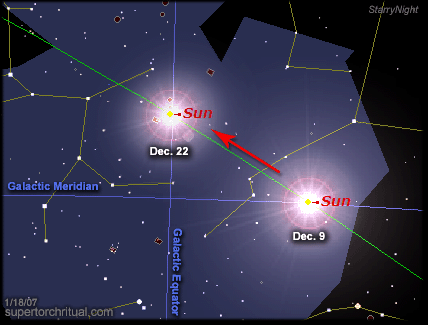

[image by Gary Palmer via spaceweather.com]
The Galactic solstice-Sun alignment is closely associated with the end date of the Mayan calendar, winter solstice 2012, when Sunspot Cycle 24 is projected to peak. The Galactic Meridian alignment coincided with the release of Mel Gibson's 'Apolcalypto', all about the end of the Mayan civilization.
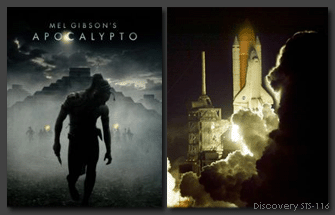
The Sun was strangely active as well...

 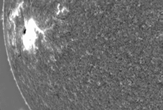
The Sun would cross the Galactic Meridian again on June 7-8 on the opposite side of the sky/ecliptic.

It coincided with the Venus Transit (= 'Grail/Messianic conception') in 2004 and the launch of Atlantis STS-117 this year.
Atlantis returned only a day after the summer solstice, when the Sun 'died' for the Southern Hemisphere.

It was another death/life Resurrection moment - acknowledged or foreshadowed by the shuttles' solstice axis expressing 'coming out of the egg' (back to life) via the STS-116 mission patch and such.

And it was Prince William, a 'Once and Future King' (Arthur) figure, 'reborn' on his summer-solstice birthday. Atlantis landed at Edwards AFB to highlight Paris, where his mother Princess Diana died in 1997. Edwards is aligned with the 'Tower Axis' (Eiffel Tower, Champ de Mars) extended from Paris.

On the 'Tower Axis' is also found the crash site of NASA's Genesis (9/8/04). It went to the Sun and came back with solar wind samples. The crash therefore signifies the Sun hitting the bottom, again expressing the phoenix death/resurrection theme.
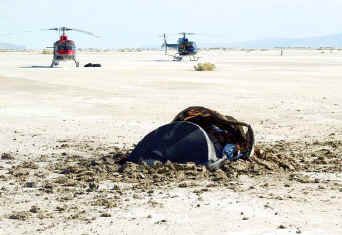
The astronomical/astrological symbol of the Sun looks like this:

It also signifies the 'Monad' - known to the Greek philosophers as 'The First', 'The Seed', 'The Essence', 'The Builder', and 'The Foundation'. Or in other words... Genesis.
Within weeks of the Genesis crash, U2 released the first single 'Vertigo' off their new album 'How to Dismantle An Atomic Bomb'. 'Vertigo' is the name of the company which provided the helicopters that were supposed to catch Genesis midair (see picture above). One of those helicopters was also named 'Vertigo'.
The connection is reinforced by the lyrics of 'Vertigo' alluding to the progressive rock/pop band 'Genesis'. Their last big hit was 'I can't Dance' from their 1991 album 'We Can't Dance' which is referenced in the second verse of 'Vertigo':
The night is full of holes
Those bullets rip the sky
Of ink with gold
They twinkle as the boys play rock and roll
They know that they can't dance
At least they know

Update: Genesis, reunited and touring this year, was the first band to perform in London's Live Earth concert.
Furthermore, the 'Vertigo' video shows U2 in the desert like NASA's Genesis, performing on a Sun/Monad symbol.
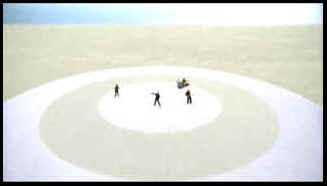
'Vertigo' was also heavily used by Apple to promote the iPod...
...showing the same Sun/Genesis symbol (the 'click wheel').

Apple's new product iPhone - widely considered the most highly anticipated consumer electronics device in history - was just released on June 29, '07, the same day as the car bomb event in London recalling the 7/7 bombings there two years ago, seemingly setting the stage for Live Earth 7/7/07... And what do we see in the Live Earth logo? The same solar symbol!

Live Earth certainly knows where it is in time (aphelion, etc.) and is the latest manifestation of the the 'Solar Resurrection' theme.
Now, whereas we see the blue sky in the Life Earth solar symbol, we see the solar symbol in the blue sky on the cover of Journey's 'Don't Stop Believing'.

The song was a major part of the enigmatic final scene of The Sopranos (HBO) that got everybody talking.

Unbeknownst to most, the episode was mostly about Solar Resurrection. So for example on Journey's 'Escape' album cover - the album of 'Don't Stop Believing' - we find the scarab beetle coming out of a sphere/egg:
Scarab in Ancient Egypt:
- The image of the scarab, conveying ideas of transformation, renewal, and resurrection, is ubiquitous in ancient Egyptian religious and funerary art.
- The scarab was linked to Khepri ("he who has come into being"), the god of the rising sun.
- The ancients believed that the dung beetle was only male in gender, and reproduced by depositing semen into a dung ball.
- The ancient Egyptians believed that Khepri renewed the sun every day before rolling it above the horizon, then carried it through the other world after sunset, only to renew it, again, the next day.
The final scene of The Sopranos was also literally a 'Last Supper', evoking death and resurrection... and the Grail. This is just the tip of the iceberg but you get the idea.
The same Sun/Genesis symbol is also in the Tour de France logo:

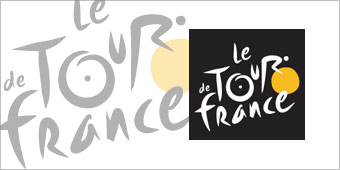
The race starts on 7/7/07 and in London - the city of Diana, Prince William, and the 7/7 bombings two years ago. The race will conclude in Paris, another 'Diana city', aligned with Genesis' crash site and Edwards AFB (Atlantis landing).

The 'Tower Axis' or the Champ de Mars (green) is highlighted by the Eiffel Tower. It's the 'Tower of France' or, since 'tour' means 'tower' in French, 'Tour de France'.

The 'Tower of France' is also Mary Magdalene - the lady of the Grail. 'Magdalene' means 'tower' and she is said to have gone to France after the Crucifixion, carrying the 'Grail' with her. The Grail is a form of the phoenix. (This also interacts with the Stuart/Grail bloodline of Diana discussed before.)
On the official Tour de France website I even found (now gone/hidden) a 'Live Earth'... being cooked by the Sun - alluding to global warming.
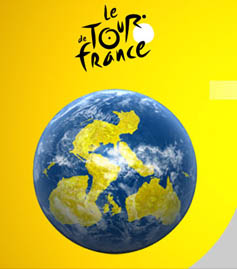
It was coded as well... Like this, for example:
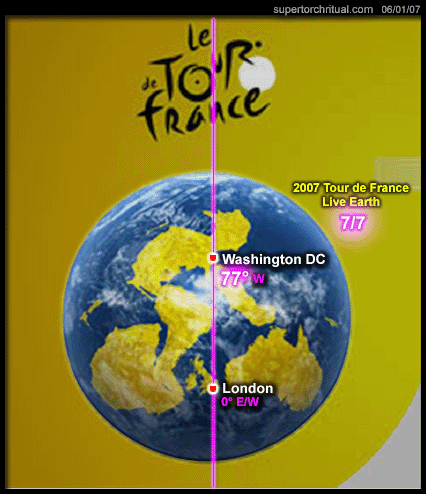
(London and Washington are both Live Earth concert sites.)
In any case, a 'Deep Impact sequence' should follow 7/7/7... Good times...
* * *
Update:
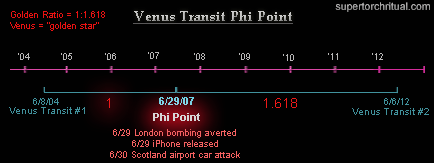
July 20 'Sunshine' released; all about... Resurrection of a dying Sun!


|
.
|
 |
|
|
© 2006 goroadachi.com
http://www.goroadachi.com/etemenanki/777-solarresurrection.htm
|
|
|
|
|
Mateo 24
1. Cuando Jesús salió del templo y se iba, se acercaron sus discípulos para mostrarle los edificios del templo.
2. Respondiendo él, les dijo: ¿Veis todo esto? De cierto os digo, que no quedará aquí piedra sobre piedra, que no sea derribada.
3. Y estando él sentado en el monte de los Olivos, los discípulos se le acercaron aparte,
diciendo: Dinos, ¿cuándo serán estas cosas, y qué señal habrá de tu venida, y del fin del siglo?
4. Respondiendo Jesús, les dijo: Mirad que nadie os engañe.
5. Porque vendrán muchos en mi nombre, diciendo: Yo soy el Cristo; y a muchos engañarán.
6. Y oiréis de guerras y rumores de guerras; mirad que no os turbéis, porque es necesario que todo esto acontezca; pero aún no es el fin.
7. Porque se levantará nación contra nación, y reino contra reino; y habrá pestes, y hambres, y terremotos en diferentes lugares.
8. Y todo esto será principio de dolores.
9. Entonces os entregarán a tribulación, y os matarán, y seréis aborrecidos de todas las gentes por causa de mi nombre.
10. Muchos tropezarán entonces, y se entregarán unos a otros, y unos a otros se aborrecerán.
11. Y muchos falsos profetas se levantarán, y engañarán a muchos;
12. y por haberse multiplicado la maldad, el amor de muchos se enfriará.
13. Mas el que persevere hasta el fin, éste será salvo.
14. Y será predicado este evangelio del reino en todo el mundo, para testimonio a todas las naciones; y entonces vendrá el fin.
15. Por tanto, cuando veáis en el lugar santo la abominación desoladora de que habló el profeta Daniel (el que lee, entienda),
16. entonces los que estén en Judea, huyan a los montes.
17. El que esté en la azotea, no descienda para tomar algo de su casa;
18. y el que esté en el campo, no vuelva atrás para tomar su capa.
19. Mas ¡ay de las que estén encintas, y de las que críen en aquellos días!
20. Orad, pues, que vuestra huida no sea en invierno ni en día de reposo;
21. porque habrá entonces gran tribulación, cual no la ha habido desde el principio del mundo hasta ahora, ni la habrá.
22. Y si aquellos días no fuesen acortados, nadie sería salvo; mas por causa de los escogidos, aquellos días serán acortados.
23. Entonces, si alguno os dijere: Mirad, aquí está el Cristo, o mirad, allí está, no lo creáis.
24. Porque se levantarán falsos Cristos, y falsos profetas, y harán grandes señales y prodigios, de tal manera que engañarán, si fuere posible, aun a los escogidos.
25. Ya os lo he dicho antes.
26. Así que, si os dijeren: Mirad, está en el desierto, no salgáis; o mirad, está en los aposentos, no lo creáis.
27. Porque como el relámpago que sale del oriente y se muestra hasta el occidente, así será también la venida del Hijo del Hombre.
28. Porque dondequiera que estuviere el cuerpo muerto, allí se juntarán las águilas.
29. E inmediatamente después de la tribulación de aquellos días, el sol se oscurecerá, y la luna no dará su resplandor, y las estrellas caerán del cielo, y las potencias de los cielos serán conmovidas.
30. Entonces aparecerá la señal del Hijo del Hombre en el cielo; y entonces lamentarán todas las tribus de la tierra, y verán al Hijo del Hombre viniendo sobre las nubes del cielo, con poder y gran gloria.
31. Y enviará sus ángeles con gran voz de trompeta, y juntarán a sus escogidos, de los cuatro vientos, desde un extremo del cielo hasta el otro.
32. De la higuera aprended la parábola: Cuando ya su rama está tierna, y brotan las hojas, sabéis que el verano está cerca.
33. Así también vosotros, cuando veáis todas estas cosas, conoced que está cerca, a las
puertas.
34. De cierto os digo, que no pasará esta generación hasta que todo esto acontezca.
35. El cielo y la tierra pasarán, pero mis palabras no pasarán.
36. Pero del día y la hora nadie sabe, ni aun los ángeles de los cielos, sino sólo mi Padre.
37. Mas como en los días de Noé, así será la venida del Hijo del Hombre.
38. Porque como en los días antes del diluvio estaban comiendo y bebiendo, casándose y dando en casamiento, hasta el día en que Noé entró en el arca,
39. y no entendieron hasta que vino el diluvio y se los llevó a todos, así será también la venida del Hijo del Hombre.
40. Entonces estarán dos en el campo; el uno será tomado, y el otro será dejado.
41. Dos mujeres estarán moliendo en un molino; la una será tomada, y la otra será dejada.
42. Velad, pues, porque no sabéis a qué hora ha de venir vuestro Señor.
43. Pero sabed esto, que si el padre de familia supiese a qué hora el ladrón habría de venir, velaría, y no dejaría minar su casa.
44. Por tanto, también vosotros estad preparados; porque el Hijo del Hombre vendrá a la hora que no pensáis.
45. ¿Quién es, pues, el siervo fiel y prudente, al cual puso su señor sobre su casa para que les dé el alimento a tiempo?
46. Bienaventurado aquel siervo al cual, cuando su señor venga, le halle haciendo así.
47. De cierto os digo que sobre todos sus bienes le pondrá.
48. Pero si aquel siervo malo dijere en su corazón: Mi señor tarda en venir;
49. y comenzare a golpear a sus consiervos, y aun a comer y a beber con los borrachos,
50. vendrá el señor de aquel siervo en día que éste no espera, y a la hora que no sabe,
51. y lo castigará duramente, y pondrá su parte con los hipócritas; allí será el lloro y el crujir de dientes.
|
|
|
|
|
Rennes Chateau: Mary Magdalene the one Jesus loved the most
by Carolyn Shield
Mary Magdalene plays a major role this past week in the Easter story of Jesus's Resurrection. She is the first one that Jesus appears to after he rises from the dead. He doesn't appear to Peter, John, James his brother, or even his mother. He appears to the one who he loves the most Mary Magdalene. She followed him through his journeys and supported his cause financially. She is at the Crucifixion, Burial, and Resurrection. Pope John Paul II has called her the "Apostle to the Apostles". She is named fourteen times in the bible more than most of the apostles. Magdalene is mentioned more than Mother Mary in the bible. Jesus cured her of a serious illness and as a result saved her life. Her bravery is outstanding when compared with Saint Peter. It is Saint Augustine who said "it was the Holy Spirit who made Magdalene the Apostle of the Apostles." We are lucky to have the Gospel of Mary Magdalene which she tells the Apostles secret teachings Jesus taught her. Jesus teaches a woman and then this woman teaches his Apostles. It is another terrific part of the story. No more Magdalene carries the false label of the prostitute but not an equal to the Apostles. Many can debate if she is seated next to Jesus in Da Vinci's Last Supper. It is her actions that speak for themselves. She has earned the right to be seated with the Apostles.
http://www.americancatholic.org/Newsletters/CU/ac0506.asp
At Rennes Chateau in France Mary Magdalene carries a cross and holds a urn. On the cross she bears is a five pointed star. The five pointed star is the symbol of Venus. Titian has a painting called Venus with Mirror. The two cherubs are there holding her mirror.
Hit the link to see the Rennes Chateau image of Mary Magdalene carrying the cross below her feet are two cherubs. In the mirror the eye of the goddess Venus is older and more wrinkled. She will be crowned by roses which have thorns. In the mirror do we see the all seeing eye of the goddess peering back at her. The Egyptian all seeing eye of the goddess Wedjet known as green one and the Greeks called it "risen one".
http://benhammott.com/mary-magdalene-skull-book-text.html
Titian Pieta is his last painting. In the painting we see Mary Magdalene with two cherubs one above and the other below. A woman carrying the cross crowned with rose crown of thorns. She was a Cumaen Sibyl who predicted the coming of the savior.
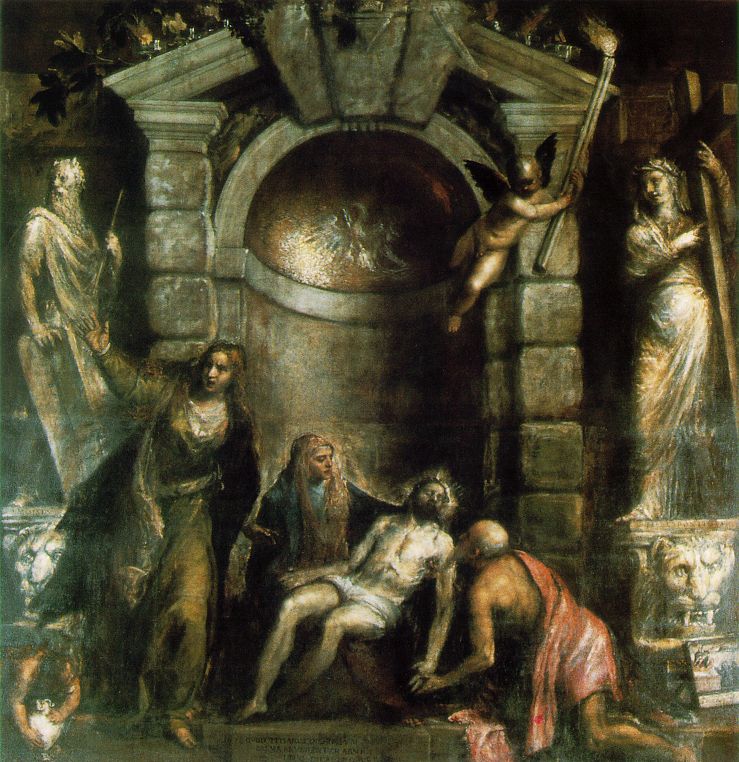
It is interesting that the cherubs under Magdalene at Rennes Chateau are pointing down and one wonders if there is a crypt under the church. The cherubs are seen in many paintings dealing with the burial of Christ. Bourdon, Poussin, Titian, and others have placed the cherubs with Magdalene and the other women at Jesus grave. These women who came to Jesus's grave possibly had children. The cherubs in the paintings maybe a symbol representing the children of the Holy Family or children of Jerusalem. Luke 23:28-31 says
"Daughters of Jerusalem, do not weep for me, but weep for yourselves and for your children. For behold, the days are coming when they will say, 'Blessed are the barren, and the wombs that never bore, and the breasts that never gave suck!' Then they will begin to say to the mountains, 'Fall on us'; and to the hills, 'Cover us'. For if they do this when the wood is green, what will happen when it is dry?"
It doesn't surprise me that Venus the goddess of Love whose symbol is the five pointed star would be connected to Mary Magdalene. It could be the reason for the symbol on the tree cross that she carries. Venus symbol has a cross in it for its astrological symbol. It is connected to the Ankh. The key of life to the Egyptians connected to Isis and eternal life.
 
Venus retrogrades every 584 days (19 months) making five retrograde points around the Sun. After eight years, Venus forms a five-pointed star in the sky. Ishtar and Astarte carry the jar of life and so Mary Magdalene carries her jar . Mark 14:3 talks about the woman with the alabaster jar. The jar the Egyptians used for the funeral rites. It seems the symbolic connections with Magdalene and Venus makes sense. She loved Jesus with such passion and he loved her by showing his resurrected self first to her. It is all about the power of love and that is what Venus and Isis is all about.
At the Cathedral of Notre Dame in Paris is a wooden panel which depicts the life of Christ. A panel depicts the Wedding of Cana. Three people have halos one is Jesus another is a woman who sits next to Jesus. . Is she Mother Mary or possibly Magdalene?One wonders who the fellow next to Jesus who has a halo too? Is he Jesus brother? Is he the bride's father? Is he the bride's groom? The lady next to him does not have a halo and she is darker skinned than the others. She does wear a gold crown and her hair is not covered. I'm interested to hear what other people think of this interpretation of the Wedding of Cana especially the saint next to Jesus. The French had a oral tradition which said Mary Magdalene came to France by boat with other saints. She brought with her the dark servant girl Sara the Egyptian. Napoleon made the Paris coats of arms the five pointed star and the ship who brought Isis to the city called Paris. It is interesting the similar story of Isis and Magdalene coming by boat to France. Napoleon created the Arch de Triumph as a symbol of Isis and her star Sirius. Isis was devoted and loved Osiris very much. I could see how Magdalene and the story of Isis could be similar. What do you think?
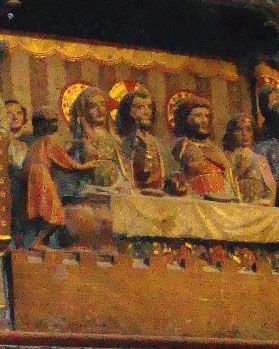
http://homepage.ntlworld.com/fusniak/talisman/articles/isisofparis.html
http://www.thestarhouse.org/MMWho.html
http://www.steeppath.com/article.php?ID=1
http://en.allexperts.com/q/Esoteric-Symbology-3874/2008/10/tell-mythology-symbolism-behind.htm
|
|
|
|
|
En otra clave o significado, "niños", Esotéricamente, son los "Iniciados", y, a quienes, se refiere nuestro Señor Jesús el Cristo:
"... De cierto os digo, que si no os volviereis, y fuereis como niños, no entraréis en el reino de los cielos." (Mateo, 18: 3).
Si la voz de un niño inocente es escuchada y acogida en los Cielos, cuanto más la voz de un Iniciado, la voz de un verdadero esoterista que se ha vuelto como un niño, y es como un niño...
JANUCÁ HANUKKÁH O CHANUKÁH
ES LA FIESTA DE LA DEDICACIÓN - LA FIESTA DE LAS LUCES
“zot chanukat ha-mizbe'ach.”
"Esta fue la dedicación [hanukkáh] del altar".
(Números 7: 84, 88).
El Rey Salomón dice en "Proverbios":
"Educad [chanoch] a un niño de acuerdo a su naturaleza;
cuando él crezca él no la abandonará."
"Y se hacía la fiesta de la dedicación [Hanukkáh] en Jerusalem; y era invierno;
Y Jesús andaba en el templo por el portal de Salomón.
Y rodeáronle los Judíos y dijéronle: ¿Hasta cuándo nos has de turbar el alma?
Si tú eres el Cristo, dínoslo abiertamente.
Respondióles Jesús: Os lo he dicho, y no creéis: las obras que Yo hago en nombre de Mi Padre, ellas dan testimonio de Mí;
Mas vosotros no creéis, porque no sois de Mis ovejas, como os he dicho.
Mis ovejas oyen Mi voz, y Yo las conozco, y Me siguen;
Y Yo les doy vida eterna y no perecerán para siempre,
ni nadie las arrebatará de Mi mano.
Mi Padre que me las dió, mayor que todos es
y nadie las puede arrebatar de la mano de Mi Padre.
Yo y el Padre una cosa somos."
(Juan, 10: 22-30).
La palabra Hebrea Chanukkáh o Hanukkáh", ("dedicación", "consagración"), proviene del Hebreo "hanakh" ("entrenamiento"), significando a su vez: "dedicar", "dar", "empezar", "comenzar".
El Hebreo "Hanokh" o "Henoch", significa también "dedicado, consagrado", "Iniciado", y viene asimismo de la palabra "hanakh".
La palabra Hebrea "Chanoch" o "Hanokh" ("Henoch"), tiene el mismo significado que la palabra Hebrea "HANUKKÁH", y vienen de la misma raíz Hebrea "hanakh", y por lo tanto, son sinónimos.
|
|
|
|
El Rey Salomón dice en "Proverbios":
"Educad [chanoch] a un niño de acuerdo a su naturaleza;
cuando él crezca él no la abandonará."
|
|
|
|
|
|
|
| 1Ki 8:63 And Solomon offered a sacrifice of peace offerings, which he offered unto the LORD, two and twenty thousand oxen, and an hundred and twenty thousand sheep. So the king and all the children of Israel dedicated the house of the LORD. |
|
|
|
| Verse # = 9049 | Words =24 | Letters = 93 |
| Data from Strong's Concordance |
| KJV |
Hebrew |
Strong's # |
Value |
| And Solomon |
שלמה |
 H8010 Shelomoh H8010 Shelomoh |
375 |
| offered |
זבח |
 H2076 zabach H2076 zabach |
17 |
| a sacrifice |
זבח |
 H2077 zebach H2077 zebach |
17 |
| of peace offerings, |
שלם |
 H8002 shelem H8002 shelem |
370 |
| which he offered |
זבח |
 H2076 zabach H2076 zabach |
17 |
| unto the LORD, |
יהוה |
 H3068 Yehovah H3068 Yehovah |
26 |
| two |
שתים |
 H8147 shenayim H8147 shenayim |
750 |
| and twenty |
עשרים |
 H6242 `esriym H6242 `esriym |
620 |
| thousand |
אלף |
 H0505 'eleph H0505 'eleph |
111 |
| oxen, |
בקר |
 H1241 baqar H1241 baqar |
302 |
| and an hundred |
מאה |
 H3967 me'ah H3967 me'ah |
46 |
| and twenty |
עשרים |
 H6242 `esriym H6242 `esriym |
620 |
| thousand |
אלף |
 H0505 'eleph H0505 'eleph |
111 |
| sheep. |
צאן |
 H6629 tso'n H6629 tso'n |
141 |
| So the king |
מלך |
 H4428 melek H4428 melek |
90 |
| and all the children |
בן |
 H1121 ben H1121 ben |
52 |
| of Israel |
ישראל |
 H3478 Yisra'el H3478 Yisra'el |
541 |
| dedicated |
חנך |
 H2596 chanak H2596 chanak |
78 |
| the house |
בית |
 H1004 bayith H1004 bayith |
412 |
| of the LORD. |
יהוה |
 H3068 Yehovah H3068 Yehovah |
26 |
|
|
חנך chanak {khaw-nak'} a primitive root; TWOT- 693; v AV - dedicate 4, train up 1; 5 1) to train, dedicate, inaugurate 1a) (Qal) 1a1) to train, train up 1a2) to dedicate
Gematria: 78
|
|
|
| Neh 12:27 And at the dedication of the wall of Jerusalem they sought the Levites out of all their places, to bring them to Jerusalem, to keep the dedication with gladness, both with thanksgivings, and with singing, with cymbals, psalteries, and with harps. |
|
|
|
| Verse # = 12652 | Words =18 | Letters = 92 |
| Data from Strong's Concordance |
| KJV |
Hebrew |
Strong's # |
Value |
| And at the dedication |
חנכה |
 H2598 chanukkah H2598 chanukkah |
83 |
| of the wall |
חומה |
 H2346 chowmah H2346 chowmah |
59 |
| of Jerusalem |
ירושלם |
 H3389 Yeruwshalaim H3389 Yeruwshalaim |
586 |
| they sought |
בקש |
 H1245 baqash H1245 baqash |
402 |
| the Levites |
לויי |
 H3881 Leviyiy H3881 Leviyiy |
56 |
| out of all their places, |
מקום |
 H4725 maqowm H4725 maqowm |
186 |
| to bring |
בוא |
 H0935 bow' H0935 bow' |
9 |
| them to Jerusalem, |
ירושלם |
 H3389 Yeruwshalaim H3389 Yeruwshalaim |
586 |
| to keep |
עשה |
 H6213 `asah H6213 `asah |
375 |
| the dedication |
חנכה |
 H2598 chanukkah H2598 chanukkah |
83 |
| with gladness, |
שמחה |
 H8057 simchah H8057 simchah |
353 |
| both with thanksgivings, |
תודה |
 H8426 towdah H8426 towdah |
415 |
| and with singing, |
שיר |
 H7892 shiyr H7892 shiyr |
510 |
| with cymbals, |
מצלת |
 H4700 metseleth H4700 metseleth |
560 |
| psalteries, |
נבל |
 H5035 nebel H5035 nebel |
82 |
| and with harps. |
כנור |
 H3658 kinnowr H3658 kinnowr |
276 |
|
|
|
|
|
|
|
|
|
|
Enoc (nombre)
De Wikipedia, la enciclopedia libre
Enoc es un nombre propio masculino en su variante en español. Procede del hebreo אנוך y significa «dedicado». Enoc es el único de la genealogía antediluviana del que no se dice “y murió”. Esto fue debido a que “le llevó Dios” (Génesis 5:18-24). Fue traspuesto para no ver muerte (Hechos 11:5).
Enoc es el nombre de varios personajes bíblicos del Antiguo Testamento:
- Enoc hijo de Caín y nombre de la ciudad fundada por Caín, a la que dio el nombre de su hijo (Génesis 4:17).
- Enoc hijo de Jared, engendro a Matusalén (Génesis 5: 18-24).
- Enoc hijo de Rubén, también trascrito como Henoc (Génesis 46:9).
La celebración del santo de Enoc se corresponde con el día 30 de julio.
|
|
|
|
|

“IVENI VERBUM IN ORE LEONIS”
( Caballero Del Real Arco 13° )
Lázaharo Hael
“IVENI VERBUM IN ORE LEONIS” (Encontré la palabra o verbo en la boca del león). Dentro del bestiario alegórico, el león es un símbolo solar de poder, fuerza y liderazgo. En el zodiaco se le asocia con el elemento fuego como la “Yod” decima letra del alfabeto Hebreo y primera en el nombre sagrado de YHVH; Dentro de los doce signos zodiacales, ocupa el quinto lugar, asociándolo por ese hecho, con el quinario la consciencia que preside el cuaternario del fuego, aire, agua y tierra.
En la iconografía bíblica aparece repetidamente el león en diferentes formas y eventos, por el ejemplo: Proverbios 30:29-31 Hay tres cosas majestuosas en su marcha, y una cuarta de elegante caminar: el león, poderoso entre las fieras, que no retrocede ante ninguna; el gallo, que se pasea erguido, asimismo el macho cabrío, y el rey cuando tiene el ejército con él”; También es posible observar junto al evangelista San Marcos a un león alado, porque en el inicio de su evangelio, se refiere a San Juan como la voz que clama en el desierto, y suponían que el león que era el rey del desierto. El desierto es un lugar árido con casi nula existencia de agua y formas de vida. En este caso es un símbolo de la materia primordial desorganizada y carente de formas o cuerpos “vivos”. El león representa la mente y poder de la divinidad que ha de insuflar su aliento al pronunciar su nombre y dando inicio al movimiento que habría de generar las formas y el universo manifiesto; y citando una referencia más, cuando “El león de Judá (Jesús el Cristo con su garra (Mano) levanta al hijo de la viuda de naín, que había muerto días antes”Lucas 7:11-17… Evento que de seguro le atraerá hermosos recuerdos de su exaltación al Maestro Masón Gr. 3°, sin embargo, el secreto permanece oculto por su propia naturaleza.
La iglesia armenia dice: “Mors, ego sum mortis. Vocor agnus aum leo fortis” Que se traduce como: “Yo soy, la muerte de la muerte. Me llaman cordero, soy un león fuerte” refiriéndose al Cristo interior o alma inmortal de toda persona… o posiblemente a Jesús el Cristo Cósmico.
El Caballero Del Real Arco Gr. 13° dice en su liturgia: “Inventi verbum in ore leonis” Que quiere decir “Encontré la palabra, verbo o logos en la boca del león” y que interpreta como: “El León emblema del pensamiento que se revela contra la fuerza y abre paso a la verdad”.
La biblia menciona en apocalipsis 5:5 a “Jesús el Cristo como el León de Judáque ha de abril el libro de los siete sellos”… Libro que posiblemente sea el cuerpo humano. Y muy posiblemente también, los siete cellos se refieran a los siete centros llamados Chakras o centros psíquicos que menciona Aldo Lavagnini en su libro <> y C. W. Leadbeater 33° en su libro <> entre otros más.
El Caballero del Real Arco Gr. 13° dice en su liturgia: “Sabed que ningún hombre vivo puede conocer a Dios más que por el pensamiento” y agrega: “No busquéis adivinar los atributos del creador, pues sólo podréis darle los que pertenecen al hombre”, “El León es emblema del pensamiento que se revela contra la fuerza y abre paso a la verdad”.
El Maestro Secreto Gr. 4° intuye por la simbología de su mandil, que la llave que es su propia alma, se encuentra pérdida en la naturaleza. Haciendo esto referencia a la alegórica caída de Adán en la materia.
El Caballero del Real Arco Gr. 13° Ha encontrado la palabra a través del pensamiento.
El Caballero Rosacruz Gr. 18° Sabe a través de las enseñanzas de su liturgia, “como” es posible encontrar su propia alma, no por la intuición o el pensamiento, sino cara a cara por los ejercicios y trabajos que se indican en su liturgia de grado.
El Caballero Kadosch Gr. 30° Es el consagrado o santo, lo que quiere decir que ha logrado ser uno solo con su alma. Y clama a toda voz: “El que venza los terrores de la muerte ascenderá más allá de la esfera terrestre y será digno de iniciado en los grandes misterios”.
En el Gr.13° del Real Arco, El león es la mente, y el verbo es el alma… Sin embargo: “El que tenga oídos, Oiga” Lc. 8:8.
Pax Vobiscum.
Lázaharo Hael,’,
Nota:
Palabras, Símbolos y Alegorías, no son verdades por sí mismas, solo señalan hacia ellas..
El presente, son, reflexiones y meditaciones personales, no necesariamente representan la opinión de la orden.
No escribo para todos, sin embargo, todos son invitados a leer.
Culiacán, Sinaloa. México. Miércoles 13 de mayo del 2015.
Liturgia Del Real Arco 13.- R,’, E,’, A,’, A,’,
La Biblia Reina-Valera Mundo Hispano.
Manual del Caballero Rosacruz.- Aldo Lavagnini.
La vida oculta en la Masonería.- C. W. Leadbeater 33°
FRANCMASONES4.BLOGSPOT.COM|DE ALCOSERI VICENTE
|
|
|
|
|
MARDOQUEO/MARDUK ES TIPO DEL SANTO GRIAL-ESTER/ISTAR-EN BABILONIA ISTAR ERA MADRE DE MARDUK-BABILONIA/BABYLON


Puerta de Ishtar, Pergamonmuseum, Berlín
The Ishtar Gate from Babylon; Puerta de Istar; שער עשתר ; بوابة عشتار;
Three names that appear more often as a sacred group of three are …
Ninki - (later became Ishtar) the mother
Enki - (later became Namakh) the father
Marduk the son
ANK = LIBERTAD = JANUKAH =JUAN 10:23 = PUERTA DE SALOMON
11. Juan 10:22: Celebrábase en Jerusalén la fiesta de la dedicación. Era invierno,
271. Juan 10:23: y Jesús andaba en el templo por el pórtico de Salomón.
This Trinity representation evolved a little further. In the ancient ruins in Syria centuries later after the belief had been passed down many generations, long before The Christ, some names were altered for unknown reasons. Perhaps in the same way the name Yeshua, a Hebrew Aramaic name was altered to become Jesus, a more acceptable Roman name after someone of the authority like Emperor Constantine had altered it. The same three Sun gods from Sumer now as follows… from left to right… Marduk the son on a lion, Enki… now as Namakh the father still retaining the bull of Taurus, and Ninki… now as Ishtar on another lion.
254. Ester 2:19: Cuando las vírgenes eran reunidas la segunda vez, Mardoqueo estaba sentado a la PUERTA del rey.
255. Ester 2:21: En aquellos días, estando Mardoqueo sentado a la PUERTA del rey, se enojaron Bigtán y Teres, dos eunucos del rey, de la guardia de la PUERTA, y procuraban poner mano en el rey Asuero.
256. Ester 3:2: Y todos los siervos del rey que estaban a la PUERTA del rey se arrodillaban y se inclinaban ante Amán, porque así lo había mandado el rey; pero Mardoqueo ni se arrodillaba ni se humillaba.
257. Ester 3:3: Y los siervos del rey que estaban a la PUERTA preguntaron a Mardoqueo: ¿Por qué traspasas el mandamiento del rey?
258. Ester 4:2: Y vino hasta delante de la PUERTA del rey; pues no era lícito pasar adentro de la PUERTA del rey con vestido de cilicio.
259. Ester 4:6: Salió, pues, Hatac a ver a Mardoqueo, a la plaza de la ciudad, que estaba delante de la PUERTA del rey.
260. Ester 5:1: Aconteció que al tercer día se vistió Ester su vestido real, y entró en el patio interior de la casa del rey, enfrente del aposento del rey; y estaba el rey sentado en su trono en el aposento real, enfrente de la PUERTA del aposento.
261. Ester 5:9: Y salió Amán aquel día contento y alegre de corazón; pero cuando vio a Mardoqueo a la PUERTA del palacio del rey, que no se levantaba ni se movía de su lugar, se llenó de ira contra Mardoqueo.
262. Ester 5:13: Pero todo esto de nada me sirve cada vez que veo al judío Mardoqueo sentado a la PUERTA del rey.
263. Ester 6:2: Entonces hallaron escrito que Mardoqueo había denunciado el complot de Bigtán y de Teres, dos eunucos del rey, de la guardia de la PUERTA, que habían procurado poner mano en el rey Asuero.
264. Ester 6:10: Entonces el rey dijo a Amán: Date prisa, toma el vestido y el caballo, como tú has dicho, y hazlo así con el judío Mardoqueo, que se sienta a la PUERTA real; no omitas nada de todo lo que has dicho.
265. Ester 6:12: Después de esto Mardoqueo volvió a la PUERTA real, y Amán se dio prisa para irse a su casa, apesadumbrado y cubierta su cabeza.
GATE=33
G=7
A=1
T=20
E=5
7+1+20+5=33
HECHOS 12
486. Hechos 12:10: Habiendo pasado la primera y la segunda guardia, llegaron a la PUERTA de hierro que daba a la ciudad, la cual se les abrió por sí misma; y salidos, pasaron una calle, y luego el ángel se apartó de él.
12:11 Entonces Pedro, volviendo en sí, dijo: Ahora entiendo verdaderamente que el Señor ha enviado su ángel, y me ha librado de la mano de Herodes, y de todo lo que el pueblo de los judíos esperaba.
12:12 Y habiendo considerado esto, llegó a casa de María la madre de Juan, el que tenía por sobrenombre Marcos, donde muchos estaban reunidos orando.
487. Hechos 12:13: Cuando llamó Pedro a la PUERTA del patio, salió a escuchar una muchacha llamada Rode,
488. Hechos 12:14: la cual, cuando reconoció la voz de Pedro, de gozo no abrió la PUERTA, sino que corriendo adentro, dio la nueva de que Pedro estaba a la PUERTA.
GATE/PUERTA
HECHOS 12:12 (1+2:1+2/3:3)
| gate in Simple Gematria Equals: 33 |
( |
g
7 |
a
1 |
t
20 |
e
5 |
) |
12:12 Y habiendo considerado esto, llegó a casa de María la madre de Juan, el que tenía por sobrenombre Marcos, donde muchos estaban reunidos orando.
|
|
|
|
|
Nine Worlds / Nine Months
If we add a sphere for the stars at the top and one for the earth at the bottom of the hexagram we get a figure similar to Manley P. Hall's Nine Worlds image below. Hall recommends that this is the form of the Norse Tree of Life, Yggdrasil. Since in the Norse cosmology the earth is at the center and the sun, as the soul's goal, is at the top, this is a geocentric image, but the basic form is the same as the hexagram image above.
 
Metatron's Cube
As you can see there are four markers for the cardinal directions which along with the first nine circles figure to us a 3D Cartesian coordinate grid and the six directions in space , what we call the 'cube of space', or Metatron's Cube (below) which should now be seen in a new light as 13 celestial spheres. If the earth is not the center as in the nine worlds image we need new points as direction markers. And we find them in Ezekiel. A man, a lion, ox and an eagle. And Rev 4 lion calf man eagle which is Aq Leo Taurus and Scorpio. the fixed signs in the zodiac. In the context of the solar system, these represent the four corners.
 
Ezekiel's story about wheels within wheels may just turn out to be an astronomical metaphor illustrated by Metatron's Cube. The sun is located correctly at the center. The new corners are the fixed zodiac signs. Six new spheres have been added to the original hexagram image for a total of thirteen. Metatron's Cube is a heliocentric version of the Nine World's image above.
Enoch
We read in the Bible that Enoch was the sixth patriarch after Adam and that he lived 365 years (the number of days in a solar year on earth) before he was transported to heaven. Kabbalistic legend tells us that he was transmuted into Archangel Metatron, as in Metatron's Cube. That is, Enoch is the 7th Patriarch (as in 7 spheres) and is associated with the sun; and Metatron's Cube is Enoch's Cube.
In the Southern Jourisdiction of the Scottish Rites the Thirteenth Degree relates to what is called the Royal Arch of Enoch (as in an arch supported by two columns). In this Enoch legend he is instructed to excavate nine chambers featuring nine arches and to hide a white cube bearing a golden triangle inscribed with the name of God. Instead of dealing with the soul's journey alone (as Metatron's Cube appears to) this legend deals with the history of the World/Universe. In Enoch's myth, the cube represents materiality in general (Shekinah), and the golden traingle represents the divine spark inherent in everything. (see Alchemy, Hasidism etc.) The lowest of the nine arcs (ark, arch) in this scheme is the earth. This is the Shekinah story again.
Manley Hall suggests that the nine worlds image relates to the nine stages of the Nordic initiation, the chambers where the rites were performed and the nine divisions of their cosmological template. Albert Pike suggests the same thing of the Enoch legend, that it pointed to a rite with nine stages that was performed literally underground, the form of which was related mathematically to their astronomical template. The logic goes like this: We'll form a club based on the nine planetary spheres, there with will be nine degrees to represent the phases of the souls journey. These numbers and ideas will inform our architecture and ceremonies. Underground chambers symbolize the womb, and nine of them would represent the human gestation period, nine months. The legend is an astronomy learning tool fashioned around the story of human reproduction.
The US Great Seal
 
If you look at the configuration of stars above the eagles head on the back of the One Dollar bill, you will see that the central stars are aligned differently than the inner ring of circles in Metatron's Cube. In the cube five circles each are aligned along three axes that cross the center point. In the seal the stars align along lines that connect every other outer point, four on each line. Lines in this configuration never cross the center point. This makes a better representation of a cubic city with 12 gates than the Metatron's Cube arrangement does. The cube features the hexagon and the seal the hexagram (st. of david).
There are 13 layers of stones on the pyramid, 13 stars above the eagle, and nine feathers in the eagle's tail. Overlapping equal circles centered on the same line (vesica pisces) help locate the corners of inscribed triangles and hexagrams. Three overlapping equal circles mark the diameter of a circle 4r or 2d wide, twice the size of the inner circle, as well as the diameters of four 1r wide circles. In the image on the right above we match the small circle at the top of the figure with the circle around the stars above the eagle.
 
The model for the seal configuration is twin tetractys of ten points each. (The Pythagoreans named the number 10 tetractys because it was the sum of the first four numbers.) The 13 symbolism in the seal could bear looking at again in light of this finding. 13 can be understood as the sun and 12 zodiac signs, 13 lunar months a year, or nine celestial spheres and the four directions as in Metatron's Cube.
The DC map
Looking at the DC map you can see that the pentagram seems to form an isoceles triangle with New Hampshire Ave as the left side. 16th Street provides the center line for that triangle that centers on the WH. Penn Ave runs from NW to SE, from Georgetown to the WH the CB and the East Branch of the Potomac. NYA crosses at the WH as well making the three axes which form the diagonals of the large rectangle in the cube. N St marks the top side of this rect. in the map.
 
The five points on 16th St are the top of the triangle, Scott Circle, the WH, the Wash Mmt, and the Jeff Mml. The points on Penn Ave are Georgetown, Washington Cr, The WH, the Nat Archives Bldg., and the Capitol. Nick Mann claims that the DC planners didn't use a hexagonal form for the map, when in fact they used it for both the map and the Great Seal design. They used a hexagon and the pentagon in the map.
Continue
|
|
|
|
|
36 EQUIVALE A 1+2+3+4+...+35+36=666
12 HORAS= SATURNO=666
SANTA CENA=666
|
|
|
 Primer Primer
 Anterior
35 a 49 de 79
Siguiente Anterior
35 a 49 de 79
Siguiente Último
Último
|
|
| |
|
|
©2024 - Gabitos - Todos los derechos reservados | |
|
|

